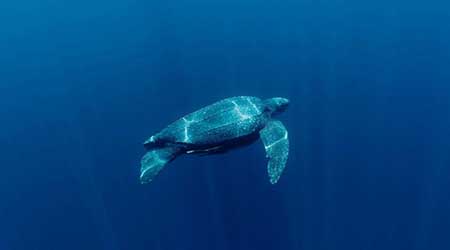Date : 27/05/2023
Relevance : GS-3 : Conservation, Environmental Pollution, and Degradation, Environmental Impact Assessment.
Key Phrases: Great Nicobar Island, leatherback turtles, construction of an international container port, Nesting Ground, Pristine Ecosystem, Threat of the Mega Port, Violation of Biodiversity Offset Principle, Insufficient Impact Assessment, Environmental Standards.
Why in News?
- Great Nicobar Island, a remote archipelago at the southernmost tip of India, is home to the largest turtles on Earth - leatherback turtles.
- However, this pristine ecosystem and its critically endangered turtle population are now facing a significant threat due to the approval of a massive infrastructure project by the Indian government.
- The construction of an international container port on the island may hinder the turtles from reaching their nesting sites, exacerbating the decline in their numbers.
Giant Leatherback turtle
- The Giant Leatherback turtle (Dermochelys) is the largest of the seven sea turtle species. Unlike the Loggerhead turtle, the other four species (Olive Ridley turtle, Green turtle, Hawksbill turtle, and Leatherback turtle) nest along the Indian coast.
- The Giant Leatherback turtle is distributed in all oceans except the Arctic and the Antarctic.
- Within the Indian Ocean, its nesting is restricted to Indonesia, Sri Lanka, and the Andaman and Nicobar Islands.
- The Giant Leatherback turtle is unique as it is the only living species in its genus and family, Dermochelyidae.
- Its distinct feature is the absence of a bony shell, which sets it apart from other modern sea turtles.
- This species is listed in Schedule I of India's Wildlife Protection Act, 1972, which grants it the highest level of legal protection in the country.
- IUCN status: Vulnerable
The Importance of Great Nicobar Island: Nesting Ground for Leatherback Turtles:
- Great Nicobar Island serves as a globally important nesting site for leatherback turtles, which can grow up to two meters long and weigh as much as 700 kilograms.
- The sub-population of leatherback turtles that nest at Galathea Bay, the proposed port site, is classified as critically endangered.
- The turtles undertake an annual journey from temperate coastal waters in Australia and Africa to nest on the island, making it a crucial habitat for their survival.
- Pristine Ecosystem and Indigenous Communities:
- Great Nicobar Island spans approximately 1,000 square kilometres and hosts a rich diversity of plant and animal species.
- The island is home to the indigenous Shompen and Nicobarese people, who have coexisted with the ecosystem for generations.
The Threat of the Mega Port:
- Massive Infrastructure Project:
- The planned development includes a mega trans-shipment port, an international airport, a power plant, and a new township.
- The construction and operation of the port are likely to impede the leatherback turtles' access to nesting sites.
- Environmental Damage:
- The construction of breakwaters to protect the port from waves will significantly reduce the opening to Galathea Bay by 90%.
- Dredging and construction activities will alter coastal habitats, such as mangroves, coral reefs, sandy and rocky beaches, coastal forests, and estuaries.
- The project may require clearing nearly a million trees, jeopardizing the habitat of various rare and endemic species.
- Violation of Biodiversity Offset Principle:
- The project's approvals rely on an offset proposal to mitigate the environmental damage by planting trees in a different ecological zone, far from the project site.
- This violates the internationally accepted "like for like" principle, which aims to conserve biodiversity through ecologically equivalent offsets.
- The plan lacks provisions to compensate for the damage to turtle nesting, further undermining the principle.
Concerns and Looking Ahead:
- Insufficient Impact Assessment:
- Approvals were granted without conducting crucial impact assessment studies, raising concerns about the project's potential consequences.
- The conditions imposed on the project do not stipulate halting work in the event of harm to Indigenous communities or the environment.
- Meeting Environmental Standards:
- Any large-scale development project affecting critically endangered species should adhere to rigorous environmental standards.
- Biodiversity offsets should align with internationally accepted principles, and if harm cannot be adequately mitigated, the project should not proceed.
Conclusion:
- The approval of a mega port on Great Nicobar Island poses a significant threat to the survival of leatherback turtles, the largest turtles on Earth.
- This project not only endangers a critically endangered species but also risks irreparable damage to a pristine ecosystem and the livelihoods of indigenous communities.
- It is crucial for environmental standards to be upheld, ensuring that biodiversity offsets align with international principles and preventing irreversible harm to this unique and fragile ecosystem.
Source: The Hindu
Mains Question:
Q. Discuss the ecological significance and conservation challenges associated with Leatherback Turtles, highlighting the measures required to protect their population and their habitat.







